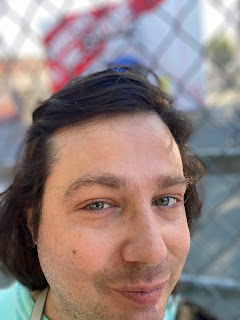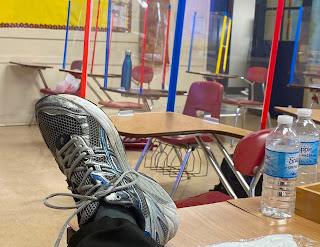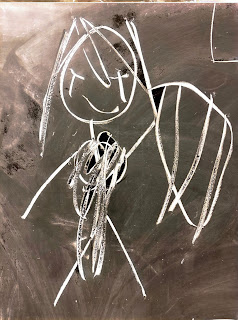Stones of Erasmus — Just plain good writing, teaching, thinking, doing, making, being, dreaming, seeing, feeling, building, creating, reading
2.10.23
Day 16 of 180: Acknowledging I'm #TeacherTired While Asking Students to Go Deeper in Their Writing
 I am an educator and a writer. I was born in Louisiana and I now live in the Big Apple. My heart beats to the rhythm of "Ain't No Place to Pee on Mardi Gras Day". My style is of the hot sauce variety. I love philosophy sprinkles and a hot cup of café au lait.
I am an educator and a writer. I was born in Louisiana and I now live in the Big Apple. My heart beats to the rhythm of "Ain't No Place to Pee on Mardi Gras Day". My style is of the hot sauce variety. I love philosophy sprinkles and a hot cup of café au lait.
17.8.23
Shaping Tomorrow's Citizens: Education, Religion, and Cultural Norms in the Classroom
In this blog post from Stones of Erasmus, I connect philosophical ideas with practical aspects of teaching and societal values. Let's invite reflection on the role of education, the influence of religion, and the importance of cultural norms in shaping the citizens of tomorrow.
 |
| The sun may appear small and lightbulb-like to the viewer, but it's actually a massive fusion-powered fireball that sustains life on Earth. |
Parity in the Classroom: The Common Gifts of Our Students
In every classroom, there lies a hidden world of potential. That gossipy student in the back row? Perhaps a budding playwright, weaving tales for the stage. Our students are not just learners; they are creators, thinkers, and future citizens.
The Personal Stance vs. The Professional Stance
Education is not just about imparting knowledge; it's a national effort to produce productive citizens. But what does that mean?
Producing productive citizens is about nurturing individuals who contribute positively to society and the economy. It's about fostering responsibility, hard work, and a commitment to the common good. It's about developing skills like problem-solving, communication, and teamwork that are vital in today's workforce.
The Image of Citizenship: A Reflection of Values
What should citizens of a country look like? The nineteenth-century image of the American family was a myth, yet it shaped perceptions. Today, we recognize that there is no one specific way citizens should look. Every individual is unique, bringing their own strengths and perspectives. The goal is to cultivate responsible, engaged members of society who contribute to the common good.
Religion and Education: A Complex Relationship
"Orderliness is godliness." This saying reflects how we often infuse public education with ideology, including the notion to "pull yourself up by your bootstrap." But do religious influences benefit the school system?
The Puritans were able to impose their ideology, but the relationship between religion and education is complex. Some believe that religious values can create moral grounding and community. Others see challenges in separating church and state, ensuring inclusivity for all students.
Folkways and Mores: The Fabric of Society
Folkways and mores are the threads that weave the social fabric. Folkways are the everyday customs and traditions, while mores are the deeper, moral values that guide a culture. Together, they shape our collective identity.
Opinions: The Personal Take on Knowledge
An opinion is more than a fleeting thought; it's your unique perspective on what you know. It's a reflection of your understanding, your beliefs, and your individuality.
PDF Copy for Printing
 I am an educator and a writer. I was born in Louisiana and I now live in the Big Apple. My heart beats to the rhythm of "Ain't No Place to Pee on Mardi Gras Day". My style is of the hot sauce variety. I love philosophy sprinkles and a hot cup of café au lait.
I am an educator and a writer. I was born in Louisiana and I now live in the Big Apple. My heart beats to the rhythm of "Ain't No Place to Pee on Mardi Gras Day". My style is of the hot sauce variety. I love philosophy sprinkles and a hot cup of café au lait.
13.7.23
Unlocking Student Accountability in Group Discussions: The Power of Self-Evaluation in the English Language Arts Classroom
 |
| Empower your ELA class! Foster accountability & reflection with Stones of Erasmus' Self-Evaluation Form. |
Imagine if your classroom could emulate this! With Stones of Erasmus' Self-Evaluation Form for Group Work, it can! This resource offers a teacher guide, a self-evaluation form, a Google Form for group work self-evaluation, and a bonus link to a FREE student note-taking template.
 |
| Exclusively from Stones of Erasmus |
 I am an educator and a writer. I was born in Louisiana and I now live in the Big Apple. My heart beats to the rhythm of "Ain't No Place to Pee on Mardi Gras Day". My style is of the hot sauce variety. I love philosophy sprinkles and a hot cup of café au lait.
I am an educator and a writer. I was born in Louisiana and I now live in the Big Apple. My heart beats to the rhythm of "Ain't No Place to Pee on Mardi Gras Day". My style is of the hot sauce variety. I love philosophy sprinkles and a hot cup of café au lait.
11.10.22
National Coming Out Day is October 11th: Here's is How One Teacher in Queens Talks About Coming Out as Both a Personal Journey and in Their Role as a Teacher
 I am an educator and a writer. I was born in Louisiana and I now live in the Big Apple. My heart beats to the rhythm of "Ain't No Place to Pee on Mardi Gras Day". My style is of the hot sauce variety. I love philosophy sprinkles and a hot cup of café au lait.
I am an educator and a writer. I was born in Louisiana and I now live in the Big Apple. My heart beats to the rhythm of "Ain't No Place to Pee on Mardi Gras Day". My style is of the hot sauce variety. I love philosophy sprinkles and a hot cup of café au lait.
16.12.21
Stones of Erasmus Teacher's Planner: Teach the Mythology of the Titan Gods and Goddesses with Middle and High School Students (Or, How to Make Mythology Relevant for Adolescent English Language Arts Students)
In this post, I briefly outline why it is both a challenge and a reward to teach mythology as a unit in a middle and high school classroom!
 |
Last year my students sat at desks with plexiglass screens, but we were still able to engage in meaningful conversations (including the meaning of myth). #thumbsup |
Mythology is a powerful topic to introduce to adolescent learners in a Language Arts or Humanities classroom. But, there's a catch. You don't want to present mythology as "kids' stuff" — and you definitely want to have a conversation about how students were first introduced to mythology — via Disney's Hercules or from a children's book, or a trip to the library, or not at all! The aura of myth is everywhere. And myths originate from all the world's societies — from the moment the first human could speak, myths have been told.
State and reiterate to students that mythology is a wide-reaching topic, and in every culture and civilization, there is a mythology — the stuff of narrative that sticks, that is universal, and tells a human story. Greek mythology is a standard go-to when teaching myth. It's standard fodder in schools today — especially because of Percy Jackson and the Lightning Thief and Edith Hamilton's Mythology. But don't just stick with the Greeks — provide a variety of mythic stories and see how they are parallel, and share common patterns.
Finding Patterns in Myth and Identifying Tropes
 |
Believe it or not — characters like Spider-man, from Marvel comics and movies — are just modern-day iterations of myth. What god would Spider-man be? Anansi? Arachne? Perhaps! |
In a middle or high school setting, it's important to contextualize myth and to make it relevant for today's learners. How do you do that successfully? The best way to do it is to show how patterns in myth crop up in our everyday world. Perhaps your students are not worried about finding a nymph on the sidewalk, or striding a bull that turns into a God — but, mythology is all around us. I love to use the website TV Tropes — it organizes common tropes found in literature, movies, television, and video games to show how popular allusions form and where they can be found! One good place to start is to show students how the Marvel Cinematic Universe is just another version of mythology, re-packaged for the new media set.
The difficulty with teaching myth to students is just simply the gulf of content that is out there. It can be overwhelming. But less is more. The goal of teaching mythology is to have students make connections. Also, older students can learn about the discrepancies found in myths, and chart out and graph those inconsistencies — such as why the stories from ancient sources change, are adapted, and evolve over time. There is no universal text when it comes to these stories — and prepare to leverage this reality to your advantage. Create group work that has students investigate the differences and similarities found in myth. And make sure to record and document what you find.
Teach a Three-Day Lesson on the Titan Gods and Goddesses
Where to start on a myth unit for middle and high school students? You can start with a lesson on creation myths, but don't forget the Titans. The Titans are the "old gods," and their stories are filled with violence, wonder, intrigue, rebellion, and the rise of the new gods, the Olympians. Learn with your students as you traverse stories that include a father castrated by his son; a wise, compassionate one who attempts to save humankind, and how a jar (or, is it a box?) unleashes mayhem onto the world!
 |
| Use a three-day lesson plan digital download from Stones of Erasmus. Adolescents will love the messiness and insanity of the old gods, the Titans. |
Engage Secondary English Language Arts students with the story of the Titans, the second-generation gods, and goddesses of Greek Mythology. Learn each Titan's backstory, where they came from, and their relationship to the Giants, and the Olympians. There is a clash of the Titans, that's for sure. Hesiod called it the Titanomachy. Use this fully packed three-day lesson plan, designed especially for students aged 13-17 years old.
- This resource is optimized for distance learning. The product includes a durable Google Apps link. Access and modify this resource for student use on Google Classroom and other classroom management sites.
Use this Digital Download for a Three-day English Language Arts Lesson
Using my tested-in-the-classroom resources, your kids will want to discuss good and bad parenting skills, cursed families, sins of the fathers, the role of women in myth, power, and the clash of the Titans! So I have loaded this resource with TEN reading cards and a set of THIRTY questions that will get your students talking, writing, and wondering!
Common Core Standards: This resource aligns well with the reading literature standard: "Analyze the representation of a subject or a key scene in two different artistic mediums, including what is emphasized or absent in each treatment (e.g., Auden’s “Musée des Beaux-Arts” and Breughel’s Landscape with the Fall of Icarus)."
This Resource Includes the Following Features:
- 1 Teacher's Three-day Lesson Calendar
- With a teacher-tested-stamp of approval, follow my suggestions on how to teach the origin story of the Titans with high school students. Start with background knowledge, places, and geography, engage students in group reading with custom-made reading cards, and quiz your class with trivia-style questions. Cap the lesson off with a creative writing activity.
- 10 Art + Literature Reading Cards
- Included in this resource are ten reading cards that cover the lives, misdeeds, and fates of all the Titans and Titanesses:
- Kronos (Saturn), Rhea, Crius, Coeus (Koios), Ocean (Oceanus), Tethys, Hyperion, Leto, Mnemosyne, Themis, Hecate, Phoebe, Iapetus, Atlas, Prometheus, Epimetheus, the Giants, the Curedes, and the Dactyls!
- Included in this resource are ten reading cards that cover the lives, misdeeds, and fates of all the Titans and Titanesses:
- 1 Key Characters and Places Worksheet
- Orient your learners by identifying the key characters and the geographical location of the story.
- A Bank of 30 Trivia-style Questions about the Titans
- After your students engage in the reading cards, test their knowledge with a custom-made question set.
- 10 Frayer Model Vocabulary Cards (with student sample)
- Frayer models are a way to get kids to think about vocabulary visually in a four-section square —- A square for meaning, one for examples, another for non-examples, and a sketch. It is amazing to see the work they produce. A great way to decorate your classroom to showcase your kids' vocabulary-in-text understanding. The cards contain terms, Greek and Latin roots, and challenging words (as well as contextual entries fit to the story).
- Half-Sheet 3-2-1 Exit Ticket
- Exit tickets are a way to get data about your students' understanding of the lesson right before the class is finished. Collect these exit tickets and quickly see what ideas your students took away from reading and discussing the myth.
- 1 Essay Writing Activity (with two visual starters and prompts)
- Cap off this three-day lesson with a creative essay prompt to get students to make text-to-world connections.
- 1 Further Reading List
- Don't disregard this further reading list if you think it is merely a bibliography. Share the list with your students or have them do projects based on the research that is available. Assign different sources to students and organize presentations where learning can go deeper into the stories of the Titans.
- Answer Keys for all student-facing documents
- Teachers always ask for answer keys for my products so I made sure I gave you plenty of guidance on what to expect from students in their written and oral responses.
- Bonus: 3-Box Notetaking Template — Embed accountability into the lesson by having students annotate the text cards with notes, questions, and a summary of what they've read and comprehended.
I created this resource with secondary students in mind. It is designed for an English Language Arts Mythology unit —
- For any myth-related unit!
- On the Clash of the Titans!
- Use this resource as a stand-alone lesson or, pair it with a larger unit on Myth, Percy Jackson and the Lightning Thief, The Theogony of Hesiod, Robert Graves's Greek Myths, or Edith Hamilton's Mythology, or Parallel Myths by J.F. Bierlein.
For resources similar to this one see my:
- Pairs perfectly with a stand-alone lesson on Kronos and Rhea, and Prometheus and Pandora! (They're basically the sequel stories to this myth)
- Greek Cautionary Tales, Apollo and Daphne, and Orpheus and Eurydice
- and my popular Plato's Cave lesson!
You can purchase this three-day lesson on Teachers Pay Teachers, Amazon Ignite, Made By Teachers, and The Wheel Education!
 I am an educator and a writer. I was born in Louisiana and I now live in the Big Apple. My heart beats to the rhythm of "Ain't No Place to Pee on Mardi Gras Day". My style is of the hot sauce variety. I love philosophy sprinkles and a hot cup of café au lait.
I am an educator and a writer. I was born in Louisiana and I now live in the Big Apple. My heart beats to the rhythm of "Ain't No Place to Pee on Mardi Gras Day". My style is of the hot sauce variety. I love philosophy sprinkles and a hot cup of café au lait.
12.5.21
Why Wednesday Is the Day of the Week to Send Messages (Because of Woden, or, as the Greeks Call Him, Hermes)
Wednesday is named for Woden — the Norse parallel for the Greek and Roman messenger god Hermes.
Ephemera
I’m obsessed with messages, epistolary novels, and journeys and undertakings. I never 👎 skip by a note or love letter. Even a torn letter I see on the sidewalk. I'll pick it up. And save it. And I love to eat tears and swallow joy.
My friends say I’m constantly flexing. My students want the school year to end. I’m listening to lots of books on tape and cooking lots of sausages and egg salad.
Achievements
I’m proud of my student @jukycheng, who got accepted into a Summer engineering program at NYU Tandon in Brooklyn. Congrats, Juky!
And I’m also excited for the Summer—those dog days. But I’m into May. With its warm afternoons and occasional showers.
Let's Chat!
How are you holding up? Need a hug? Here’s one. Need a nudge? Here’s one? Need a ride on a white swan? I don’t have that, but drop me a message if you want to chat about YA novels and the best place to walk in New York City.
 I am an educator and a writer. I was born in Louisiana and I now live in the Big Apple. My heart beats to the rhythm of "Ain't No Place to Pee on Mardi Gras Day". My style is of the hot sauce variety. I love philosophy sprinkles and a hot cup of café au lait.
I am an educator and a writer. I was born in Louisiana and I now live in the Big Apple. My heart beats to the rhythm of "Ain't No Place to Pee on Mardi Gras Day". My style is of the hot sauce variety. I love philosophy sprinkles and a hot cup of café au lait.
9.4.21
On Positivity and How I Am Dealing With Teaching and Promoting Anti-Hate (#stopasianhate #stopblackhate #love)
 |
| "Girrrrrrllllllll!" is my general mood as of late. |
.... she came to me after class and was like, “Thank you for always being positive.” And I was like, “Well. I can embrace my sadness. But it's important not get distracted by the negative.” Like. I mean — I'm not oblivious to the Rainbow of emotions. But I like to infuse joy, especially with adolescents. It is the way I connect, and it's the glue to keep a classroom together. That and reading, writing, and arithmetic.
 |
| My two English colleagues and besties. |
It’s been a stressful year — Covid-19. A disrupted school year. And a tragic time. George Floyd. Breonna Taylor. Say their names. And Asian Hate 😡.
One of my kids said this week, “I don't like coming to school. I like school. It's just getting there. Should I bring mace?” I told him — “Your feelings are valid.” And we talked about strategies to signal for help if a hater ever comes at you. Pretend to talk on the phone. Don't travel alone or on a lonely street.
All this hate takes its toll. It's toxic.
What are you doing to help folks feel safe? What should we be doing? Am I right to spread positivity? Even when I'm sad or broken, or I feel like I can't find the energy to teach or do whatever. I got this.
.
.
.
.
#covidstories #highschoolenglishteacher#stopasianhateのヴィジュアルを掲出しています #stopasianhate活動#stopviolence #stopblackhate #stopasianhatenyc 😥😔💔😞😩 #positivevibes #love #stopasianhate❤️😔 #stopasianhate能看到 ✊🏽✊🏼✊🏾✊ #stoppeopleofcolorhate❤️#stopasianhate❌#stopasianhatecanada #motivation via stonesoferasmus.com
 I am an educator and a writer. I was born in Louisiana and I now live in the Big Apple. My heart beats to the rhythm of "Ain't No Place to Pee on Mardi Gras Day". My style is of the hot sauce variety. I love philosophy sprinkles and a hot cup of café au lait.
I am an educator and a writer. I was born in Louisiana and I now live in the Big Apple. My heart beats to the rhythm of "Ain't No Place to Pee on Mardi Gras Day". My style is of the hot sauce variety. I love philosophy sprinkles and a hot cup of café au lait.
8.1.21
A Fourth Grader's Optimism: Who Needs Some Inspiration? (Especially After the Tumultuous Events in Washington, D.C. this Week!)
Feeling the need to be inspired, I found this post-it note on a bulletin board at the school where I am a high school English teacher. I teach in a K-12 school in the New York City borough of Queens.
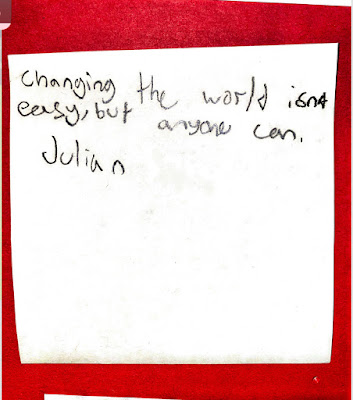 |
| Julian in Fourth Grade doles out a massive dose of encouragement. |
Needing Positivity this Week (For Sure!)
I am usually the teacher who brings positivity to the classroom. But lately I have been feeling down-and-out. Maybe it's the global pandemic that has swept the world, or maybe it's the attack on our democratic institutions on Wednesday that threw the nation's Capitol building in lockdown when a large group of Trump-inspired far-right rioters breached security protocol and entered the federal building, breaking glass, vandalizing the Speaker of the House's office, and even infiltrating the Senate chambers — where just an hour before, legislators had convened to accept certified electoral college votes from the states — to follow through with the Constitutional process to de facto validate the election of the next President of the United States, Mr. Joseph R. Biden, Jr.Inspiring Note from a Fourth Grader
And I saw this note from a Fourth grader. Kids at this age have an optimism and clarity for both big-spectacled dreams as well as practical sense. Who doesn't want the world changed for the better. But I love how he admits it is a challenge. And kudos for his marvelous grammatical construction — "Changing the world isn't easy, but anyone can."
 I am an educator and a writer. I was born in Louisiana and I now live in the Big Apple. My heart beats to the rhythm of "Ain't No Place to Pee on Mardi Gras Day". My style is of the hot sauce variety. I love philosophy sprinkles and a hot cup of café au lait.
I am an educator and a writer. I was born in Louisiana and I now live in the Big Apple. My heart beats to the rhythm of "Ain't No Place to Pee on Mardi Gras Day". My style is of the hot sauce variety. I love philosophy sprinkles and a hot cup of café au lait.
5.11.20
Share Word Power With Students (Or, Watch a Frenetic Teacher Talk About Latin Roots)
 I am an educator and a writer. I was born in Louisiana and I now live in the Big Apple. My heart beats to the rhythm of "Ain't No Place to Pee on Mardi Gras Day". My style is of the hot sauce variety. I love philosophy sprinkles and a hot cup of café au lait.
I am an educator and a writer. I was born in Louisiana and I now live in the Big Apple. My heart beats to the rhythm of "Ain't No Place to Pee on Mardi Gras Day". My style is of the hot sauce variety. I love philosophy sprinkles and a hot cup of café au lait.
21.4.20
Philosophy in the Classroom: Friedrich Nietzsche's Concept of "Eternal Recurrence" Paired with Groundhog Day — the 90s Movie Starring Bill Murray
 |
| Get this lesson and other lessons from my TpT store. |
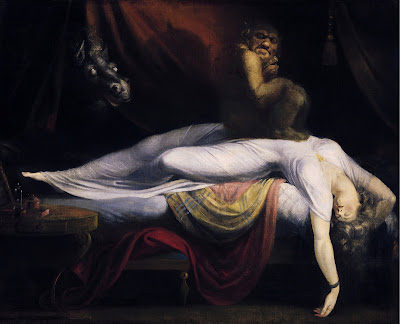 |
| The demon on your chest — would you curse the demon or embrace your fate? |
- Teacher's notes on using this resource
- 7 reading comprehension questions
- 1 Entrance Ticket
- 1 Movie View Guide
- 1 Writing Prompt
- 3 Editable Google Slides handouts
- Further Reading List (To go deeper into the topic with your students)
- Ninth or Tenth Grade High School English Curriculum
- World History Course on the History of Ideas
- Introduction to Philosophy Course
- Literature Course
- Ethics Course
- Introduction to Philosophy Course
- Student Advisory Course
- A Lesson on the "Meaning of Life"
 I am an educator and a writer. I was born in Louisiana and I now live in the Big Apple. My heart beats to the rhythm of "Ain't No Place to Pee on Mardi Gras Day". My style is of the hot sauce variety. I love philosophy sprinkles and a hot cup of café au lait.
I am an educator and a writer. I was born in Louisiana and I now live in the Big Apple. My heart beats to the rhythm of "Ain't No Place to Pee on Mardi Gras Day". My style is of the hot sauce variety. I love philosophy sprinkles and a hot cup of café au lait.





